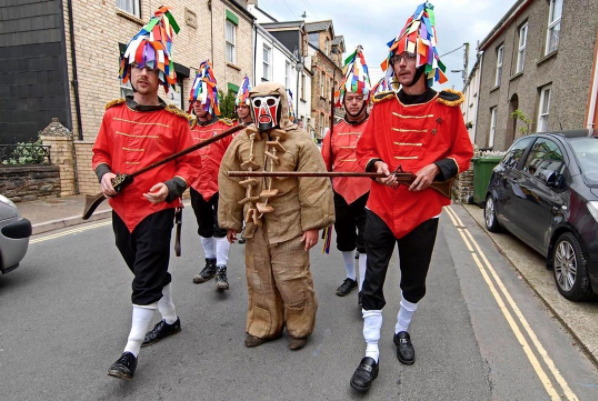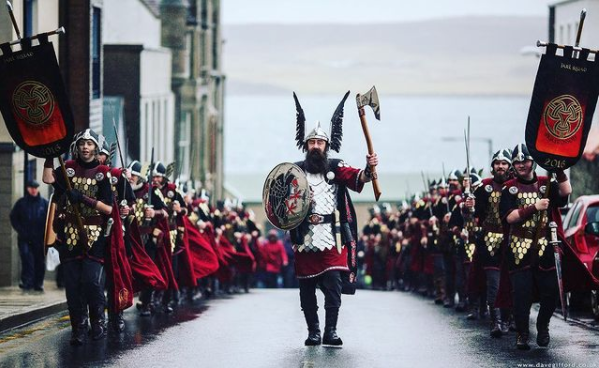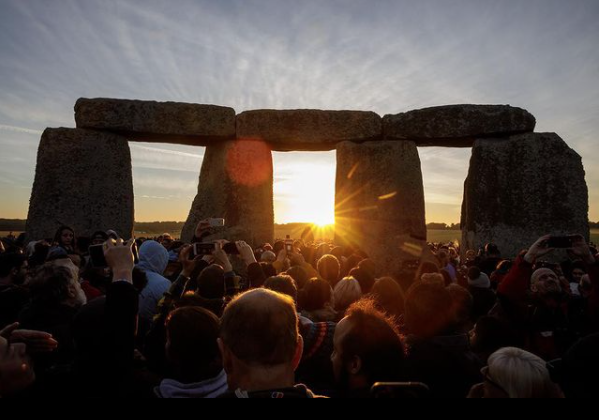We Brits are a funny bunch, we’re very passionate about a number of things: the correct way to make a cup of tea for one, our heritage for another… Another thing that sets us apart from our friends across the ocean is our dedication to some of the stranger parts of our culture and heritage.
Here are ten of our favourite weird festivals that you can only find here in Britain!
Hunting of the Earl of Rone
Combe Martin, Devon, England

Image: Hunting of the Earl of Rone / photo from @the_feral_borders on Instagram.
Combe Martin is a small village on the coast in Devon and each year, the residents come together to re-enact a centuries old manhunt. A man from the village dresses up and dons a mask and is then pursued through the town by Grenadiers, who catch and shoot him every now and then, only for him to be saved by a Hobby Horse. Every time he is revived, the hunt continues. It finally ends when the hunt reaches the seashore, the man is thrown in the sea until next time.
It is thought that the festival has historic roots, the Earl of Tyrone, who escaped Ireland in the 1600s and was shipwrecked in Combe Martin where he was hunted down by the Grenadiers. Though why it has been adopted as an annual event is anyone’s guess.
Twelfth Night
Bankside, London, England
Not to be confused with the play, this event marks the biblical day of Ephiphany (or twelfth night), it does however still contain a number of pagan elements, much like the play. At the festivities, a Holly Man (similar to the play’s Green Man) is borne along the Thames in a small boat before joining in with a number of wassails. The Holly Man is supposed to personify renewal, so it is pretty apt considering it takes place at the beginning of the year. Alongside this, there is a Mummers Play and visitors should look out for a bean in the Twelfth Night Cake – it’s a lucky omen.
Royal Shrovetide Football
Ashbourne, Derbyshire, England

Image: Royal Shrovetide Football, photo from @shrovetidelive on Instagram
Every year on Shrove Tuesday (aka Pancake Day) and Ash Wednesday, residents in Ashbourne put on the biggest and longest football game in the world. The entire town becomes a pitch and the residents divide into two teams with well over 100 players. The game can last up to 8 hours, sometimes longer and doesn’t follow the traditional rules of the game – goals can only be scored by a predetermined player, rather than anyone on the team. There are records of these games taking place since the 12th century, with some historians even saying that the match was developed during the 100 Years War with France and others, more grotesquely, saying that the match originated when residents played with the severed heads of executed prisoners.
Fireball Whirling
Stonehaven, Aberdeenshire, Scotland
Taking place during Hogmany or New Year, the people of Stonehaven parade through the streets twirling balls of fire in the air while a band of bagpipers play away alongside them. At the end of the parade, the fireballs are thrown into the North Sea and then residents “first foot” their neighbours – basically running from house to house for a dram of whiskey.
Originally, the fireballs were made from combustibles such as coal, wood and fir cones and were so big that you were often in danger of being burned, these days there are safety measures in place!
Cheese Rolling
Coopers Hill, Gloucestershire, England

Image: Cheese Rolling, photo from @neatcastpod on Instagram
If you’ve not experienced the Cheese Rolling Festival before, you might wonder why so many people have tried to ban it. What can be so dangerous about rolling cheese? Well… This is one of those extreme festivals that you won’t find anywhere else. Starting in the 15th Century, Cheese Rolling continues to be one of the most popular events in Gloucestershire. Basically, dozens of contestants chase a 9lb wheel of Double Gloucester cheese down a steep hill. The cheese is given a head start and can reach speeds of up to 70 miles an hour, which if you’re caught in the crossfire, can be a bit dangerous. It is perhaps one of the riskier cheese related activities and takes place every year during the Spring bank holiday.
The Padstow Obby Oss
Padstow, Cornwall, England
Arguably Britain’s oldest dance festival, this event, roughly translated from the Cornish means Hobby Horse and takes place every May Day. Its origins are unclear though historians think it could be derived from Pagan fertility festivals, ancient Celtic horse worship or a warning to invaders. Whatever it is, the event sees thousands of people come to Padstow every year to watch the festival, where dance troupes take to the streets led by an Oss (or a Hobby Horse, aka someone in a horse costume), the Old Oss then captures young women while the Blue Ribbon Oss brings peace. Both of them dance around the town before retiring to their stables.
Up Helly Aa
Lerwick, Shetland

Image: Up Helly Aa, photo from @uphellyaa on Instagram
Up Helly Aa is Europe’s biggest fire festival and is thought to be as authentic a Viking Festival as can be found in modern times. This is despite the fact that it doesn’t actually have Viking roots, having been developed in the 19th century. That doesn’t stop thousands of tourists from visiting to take part in the day long event which begin with marches and ends with 900 burning torches being launched onto a replica Viking ship and a ceilidh. The event takes place every year on the last Tuesday of January.
World Toe Wrestling Championships
Ashbourne, Derbyshire, England
Much like arm wrestling, the aim of the game is to defeat an opponent by pinning them down, the difference being you have to grip each other’s bare feet with your toes. Also like arm wrestling, toe wrestling can get rough and there are often stories of broken and bruised toes following the event.
It was invented in the 70s and soon became popular in the North of England, though sadly, the International powers that be won’t allow it to become part of the Olympics.
Summer Solstice
Stonehenge, Wiltshire

Image: Stone Henge on the summer solstice, photo from @samfrostphotos on Instagram
One of the most enduring British events has been celebrating the summer solstice at Stone Henge. Usually, the rocks are fenced off to protect them, but once a year, the team at English Heritage, who manage the site, allow revellers to gather among them for sunrise on the summer solstice. Many of those that come for the event do so in traditional costume and can often be seen congregating the day before to ensure the best spot in the centre of the stones.
Bog Snorkelling Championships
Llanwrtyd Wells, Wales
We thought we’d save the weirdest for last, as yes, this is exactly as it sounds. Competitors snorkel through a bog in Wales. The aim is for everyone to complete two lengths of a 60 yad trench cut through a peat bog in the shortest time possible whilst wearing a diving mask, snorkel and flippers. The catch? You can’t swim through the bog, you have to reply on the power of your flippers alone.
It has been taking place for over 30 years having been invented in the Neuadd Arms in Llanwrtyd Wells and has gone on to become one of the world’s 50 top things to do. Competitors now come from all over the world to take part and even more come to watch – some of them even complete the course in full fancy dress – though they must of course still have the snorkels and flippers!
You can keep up to date with heritage events and attractions by keep an eye on our what’s on pages.
Related
Comments
Comments are disabled for this post.

.png)


 to add an item to your Itinerary basket.
to add an item to your Itinerary basket.



